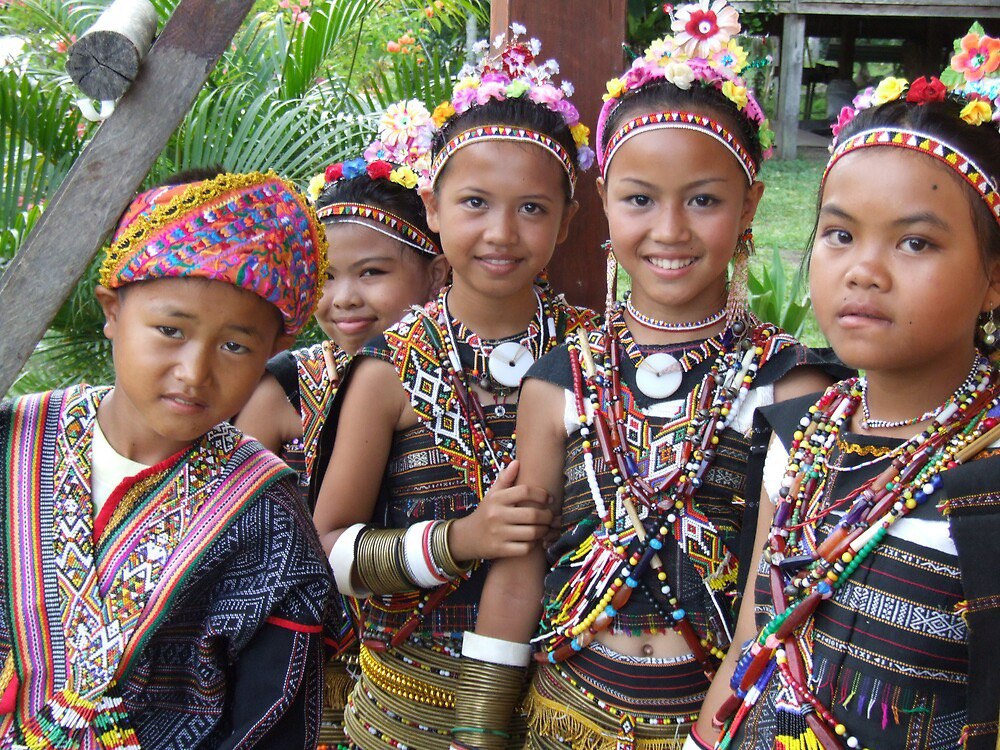Poeple of Sumangkap
The Rungus are a people of northern Borneo who live in the Kudat Division of Sabah, Malaysia. The Rungus identify themselves, their customs, and their dialect group (isoglot) by the autonym Rungus. A number of other self-ascribed Dusunic-speaking ethnic groups live in the Kudat Division, including the Nulu' and the Gonsomon, both of which sometimes are mistakenly identified as Rungus.The Rungus dialect is a member of the Dusunic language family. The Rungus tirbe believe in Celestial gods (osunduw) provided help to humankind through the work of the spirit medium/priestess, the bobolizan. These gods stood in contrast to rogon, who were the embodiment of the social and physical environment and could be harmful to humans. Rogon were found in aspects of the landscape that had distinctive features: a landslide, a large group of boulders, a grove of trees with a spring or wet place, or a banyan tree. They were the most salient osunduw in everyday discourse because they were the most dangerous to human beings. They were capricious and irascible and caused afflictions if they were not properly treated or if their living space was intruded upon. Rogon had families and engaged in the same activities as human beings. Invading the living space of a rogon, for example, by cutting a grove of trees in which a spirit dwelled, could anger the spirit, who would cause illness in the family of the perpetrator. Other rogon also could cause misfortune and infertility. These afflictions could be removed only through a sacrifice of pigs and chickens to reestablish the state of goodwill. In the past a human sacrifice to remove the afflictions of a whole village occurred occasionally. Wandering rogon brought epidemic diseases. In addition to these spirits and the rogon who personified the natural world, there were rogon called rusod who mirrored the social organization of the household. After the birth of a child, the child's rusod came into being. These spirits lived in the longhouse apartment along with the family. The rusod were the guardians of the proper cultural order in the household and the protectors of the household members. The rusod could be offended by violating any of the rules that governed the household order.
The rusod thus not only would cease to protect members of the family, allowing other rogon to make a household member ill, but also would cause a member to become ill until they were propitiated by ceremonies and sacrifices. Rice spirits (odu-odu) mirrored the social order of the family, reflected its social and jural substantiation, and provided good harvests if they were treated well and sacrificed to. There were celestial counterparts of the individual spirits that lived in the lower level of the upper world who provided protection when an individual was in danger. An individual had three to seven souls. There is one main soul of the body and other souls that reside in the joints. Souls are prone to wondering during a dream and can be captured by rogon, causing illness. The family most frequently consists of a husband and his wife—the two founders—and their children. The parents or a widowed parent of one of the founders may join the family once the youngest child is married. The family was the only producing, consuming, and assetaccumulating social unit in Rungus society. It was thus the most important corporate entity in the economic, jural, and ritual realms. Surpluses from the domestic family's swiddens and its livestock production were converted into brassware, gongs, ceramic ware, and female ornaments, including ritual clothing, old beads, earrings, and brass wire coiled around the legs, arms, waist, and sometimes necks of young girls and women. The corporate nature of the family was symbolized in the religious system. A number of sacrifices were made to cure illness in the family or to create an enhanced ritual state between the family and members of the spirit world who are responsible for protecting the family from illness and harm and promoting fertility in the swiddens and fecundity among the family's domestic animals. In the Rungus tribe men and women traditionally inherited from both sides of the family, although some items were passed down from mother to daughter and from father to son and children are highly valued, and socialization is permissive and supportive. Men traditionally were closely involved in the process. Learning was by imitation. There were no formal procedures for socialization.

